9 Types of Cedar Trees & Their Uses [Identification Guide]
Author: Jen Worst | Editor: Omar Alonso
Review & Research: Jen Worst & Chris Miller

Being able to identify the types of cedar trees when out in the wild not only makes you look smart, but you can then find the right saplings to transplant to your own yard, or grow a bonsai, or sell in your nursery.
Cedar trees are found quite frequently in nearly every part of the world too where the climate is mild to moderate. These are evergreen trees with leaves that grow all through the year. They have a strong and intense smell which is one of their defining traits.
While there are many cedar tree types, they're mostly categorized into true and faux cedar trees. All of them are evergreen, coniferous, and grow in mountainous regions all around the planet.
All mature cedar trees grow large and tall. Their leaves are sharp like needles and come in different colors. They need well-draining soil and typically grow in areas with good rainfall. Let's take a look at the different types of cedar trees now.
9 Types of Cedar Trees
There are four types of true cedar trees, which belong to the cedar genus. The faux cedar trees belong to the cypress family. The true cedars have woody pegs and needle clusters for leaves.
Whereas the faux cedars have soft and scaly leaves that resemble feathers. They look spiky and have bright-colored leaves. As the tree matures, they turn scaly and the cones on these trees look like small berries.
1) Deodar Cedar
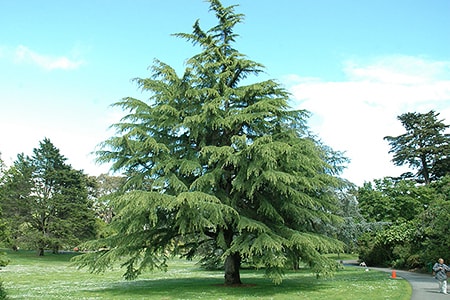
Scientific name: Cedrus deodara
These plants get their name from the Sanskrit word "devadaru" which means "the timber of gods" and they are famously known for their "weeping". You can find these cedars in open spaces like parks and gardens because they make the landscape around them very pretty with their beautiful leaves.
Identifying the deodar cedar is quite easy thanks to their striking appearance. Their gorgeous blue and green-colored leaves grow about one or two inches and look like needles.
They grow up to a height of 40 to 50 feet. And like the other cedar tree varieties, they need a lot of sunlight and grow really well in sandy and moist soil. This variety has also been given the Award of Garden Merit from the Royal Horticultural Society.
2) Atlas Cedar
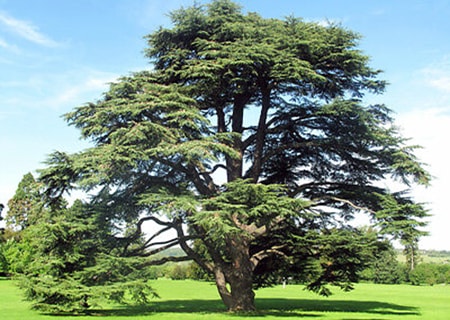
Scientific name: Cedrus atlantica
This one is another coniferous tree that grows well to a height of 40 to 60 feet on large properties. Its trunk has an impressive diameter of five to six feet. When you're out and about, see if you can spot any of the types of aspen trees when you see a cedar tree.
The tree is native to Morocco’s Atlas mountains that it gets its name from and grows at a pace of slow to moderate. It's wide and grows in the shape of a pyramid which makes its shadow look wide.
Its leaves are silvery-blue in color and are typically about an inch long. Unlike the deodar cedar, this variety can grow just fine in partial sunlight although the soil must be well drained.
The tree can tolerate heavy wind and drought well but it does get affected by pests. If you’re growing this tree, you need to make sure it is fertilized with stuff that encourages sturdy growth. To avoid shedding, trim the tree while it is still young.
3) Cyprus Cedar
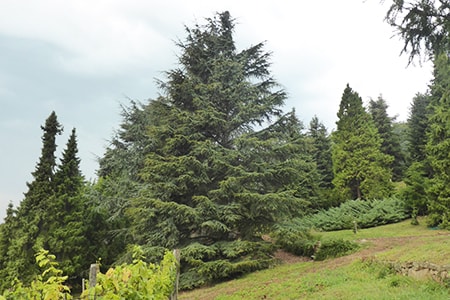
Scientific name: Cedrus brevifolia
As the name indicates, this cedar tree species is native to the mountains of Paphos, Tripylos, and Troodos in Cyprus. It's a relatively small area which makes this variety a rare species. In fact, it is one of the rarest true cedar tree varieties.
It looks a lot like the cedar tree types of Lebanon but smaller. The stature, leaves (or needles), and the pine cones are all smaller. The leaves are dark blue-green and are neat and compact.
This variety must also be exposed to full sunlight but does not need as much space as the other cedar trees. When fully grown, the tree is medium to large size. So, it still needs a good amount of space to grow.
When in its native habitats, it grows 80 feet tall. But ornamental varieties only grow up to 50 feet. It can grow in different types of soil as long as they are well draining. The Cyprian cedar needs to be watered only occasionally as it can handle a little bit of a dry spell.
4) Cedar of Lebanon
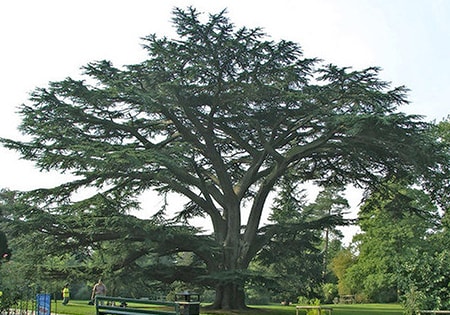
Scientific name: Cedrus libani
This is not the rarest but is quite a unique species of true cedar. It grows on the mountains of Cyprus, Turkey, and some parts of Syria.
Also called yellow cedar, this variety is quite famous for its tiny leaves and a crown that resembles an umbrella. It's even compared to the Cyprian cedar sometimes because of the resemblances.
But both species do have some differences in terms of their physical attributes. One of the main differences is that the cedar of Lebanon has elongated leaves whereas the Cyprian cedar has short and round leaves.
Faux cedar trees, on the other hand, are not from the cedar genus but have a lot of resemblances to cedar and hence the name. They too are evergreen and coniferous trees.
5) Western Red Cedar
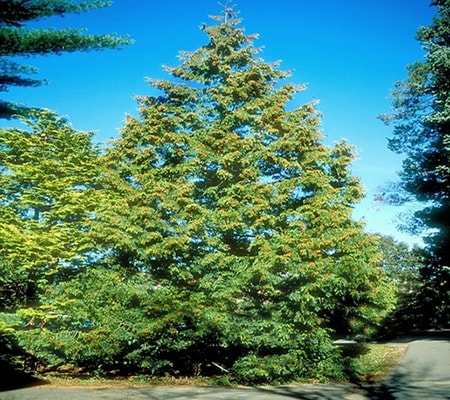
Scientific name: Thuja plicata
These types of cedar trees are native to parts of Canada and the US and belongs to the Cupressaceae family. Also called the Pacific cedar, it's one of the most common species of cedar found in the Pacific northwest.
These trees are humongous and grow up to 200 feet in height. Some of these trees have been known to live for as long as 1,000 years. Their bright green leaves release a beautiful pineapple-like aroma when you crush them with your fingers.
Western Red cedar wood is typically used in outdoor construction like fences, posts, decks, and sheds because of its impressive resistance to decay. They work well as part of a living fence, a DIY wattle fence, and any of the fence alternatives.
6) Eastern Red Cedar
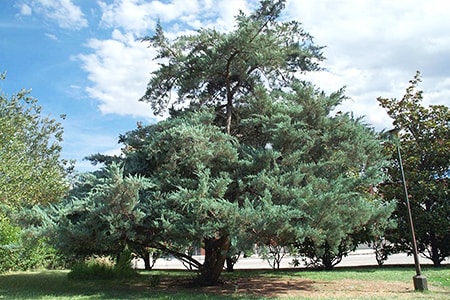
Scientific name: Juniperus virginiana
The second of the faux cedar tree varieties is scientifically called Juniperus virginiana and belongs to the Cypress family. This tree is native to the eastern areas of the US and grows from 65 to 130 feet tall.
In some exceptional cases, it is known to grow up to 100 meters or higher too. It's popularly called the aromatic cedar because of its intense smell.
The wood is used in making organic oils and also used in lining closets because of its resistance to insect infestation. This tree produces some of the most durable and versatile variants of wood that are used in making furniture.
7) Northern White Cedar
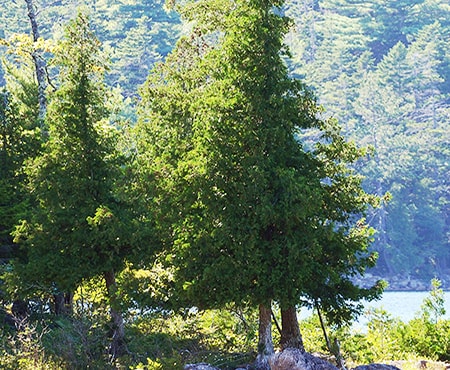
Scientific name: Thuja occidentalis
A narrow pyramid-shaped tree with dense branches, the Northern White cedar is blessed with an abundance of green needle-like foliage which has a truly great earthy fragrance. The tree grows slowly but can handle many types of soil.
But if you help it, plant it in moist and well-draining soil. The species is native to North America but it grows in many other parts of the world like Europe.
8) Spanish Cedar
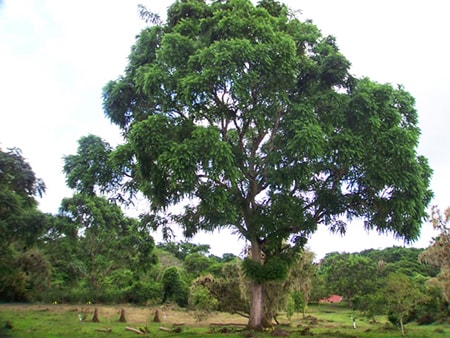
Scientific name: Cedrela odorata
This cedar tree species is native to Central and South African regions and is known to be extremely lightweight. A lot of builders and wood cutters use it in the construction of windows, cabinets, and tables, etc. for that reason.
It's hard to spot these trees in Europe and the US. But it’s quite popular in these regions, mainly because of its resistance to moisture and pets. It is also used in making oils.
The tree itself is planted in straight-lined areas so that it is easy to cut it using machines. It's typically found in pink or brown colors but can darken over time. This is a durable and versatile plant that can fight off pests and decay on its own. It's also easy to maintain.
9) Alaskan Yellow Cedar
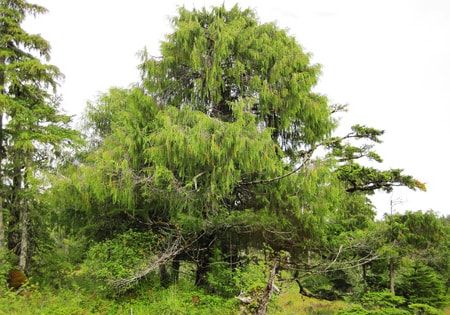
Scientific name: Cupressus nootkatensis
The Alaskan yellow cedar, the last of the faux cedar species, belongs to the Cypress family and is native to coastal regions of North America. The tree grows slowly and has drooping branches that are filled with dark green foliage.
This tree produces wood that used to be considered one of the finest and was used to build ships and in high-end flooring. When it comes to coveted timber varieties, this one is still quite popular because of its resistance to insects, splintering and even the weather.
Of course, that makes it one of the most expensive types of wood. Since it grows slowly, it's used in finishing carpentry while building cabinets and panels. Of the types of cedar trees, this one is among the most valuable.
Which of the Types of Cedar Trees Do You Prefer?
Cedar trees are pretty easy to identify. Apart from looking magnificent, true cedars have bluish-green needles for leaves and they grow in groups with woody branches.
They also have large cones that look like barrels and grow upwards on the branches. Once a tree matures, you'll find the bark to be reddish-brown with scales that can be easily peeled.
Many cedar tree varieties produce durable and strong wood that's often red in color and is used in construction. And that has been the case since the Middle Ages. It was used in building ships, weapons and so much more.
If that doesn’t impress you, well, then you’re going to be looking for a while. The types of cedar trees can be discussed forever, especially when it comes to their uses.



